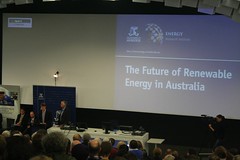 Image by Takver via FlickrBy Ashly Sun
Image by Takver via FlickrBy Ashly SunDubbed as Australia's Renewable Energy Target program, the program is a means for Australia to acquire 20 percent of its energy use from renewable energy sources by the year 2020, mainly through using renewable energy certificates (R.E.C.'s) that are given to large-scale project developers.
The program enables certificate holders to sell their certificates to those who consume more energy such as utilities. The utilities are required to get 20 percent of their electricity from alternative energy.
Under the Gillard government, households with small-scale alternative energy capabilities are also allowed to sell certificates. The increase in certificates of up to five times had decreased the market price for R.E.C.'s, resulting in the pulling out of big investors in the wind, solar, and other energy projects.
The decision to include certificates sold by the small-scale renewable energy almost cost the Australian government to lose around 22 billion Australian dollars worth of this projects, prompting the re-organization of renewable energy programs so that cheap renewable energy certificates would be abolished from the market.
Under the new program, a small-scale scheme can now be distinguished from a large-scale scheme starting on January 1, 2011.
The fixed price for small-scale projects like domestic solar panels will be 40 Australian dollars per megawatt-hour of electricity generated, equivalent to a refund of 1,200 Australian dollars for a solar hot water system and 6,200 Australian dollars for a 1.5 kilowatt solar panel.
Although prices for large-scale resources are not given, the government expects at least 45,000 gigawatt- hours from the combined efforts of both small and large-scale efforts by the year 2020.
Together with New Zealand's utility firm Meridian Energy, AGL Energy will be building the MacArthur project which is expected to generate 945 gigawatt of electricity every year. Construction is expected to be completed within three years after the start of the project.
The MacArthur project is expected to fulfill part of Australia's annual acquired energy from large-scale projects target of 10,400 GW by 2011, 18,000 GW by 2015 and 41,000 GW by 2020.
AGL Energy is the biggest Australian gas and electricity retailer. Listed on the Australian Securities Exchange, AGL aims to expand its industry in upstream electricity and gas supply, and the downstream retail of electricity and gas.
Ashly Sun is a seasoned writer, having traveled around the world, largely putting all her experiences and the sights and sounds she has come across to paper. She now writes extensively about topics related to green news, mostly on renewable energy, but also on a variety of related topics as well. When not traveling around the world, she is based in Central Hong Kong, taking in the myriad colours, flavours, and scents of the melting pot that Hong Kong is known for.
Article Source: http://EzineArticles.com/?expert=Ashly_Sun
http://EzineArticles.com/?Green-Business-in-Australia-Gets-a-Lift-From-Renewed-Green-Energy-Policy&id=4831297

No comments:
Post a Comment